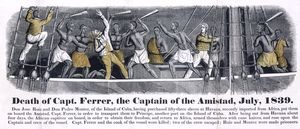
“When we oppress others, we end up oppressing ourselves. All of our humanity is dependent upon recognizing the humanity in others.” (Desmond Tutu)
As we think and consider the past, as well as the bravery and strength it took to make it through the traitorous conditions slaves were faced with every day, we are often faced with the injustice circumstances that took place and often find ourselves wondering how slaves were able to live in these conditions and still have a sense of hope. I often remember the book entitled Oroonooko by Aphra Behn. Oroonooko was faced with the harsh reality of being captured and sold into slavery. Instead of being bitter and refusing to work, he instead does so with poise and dignity. Oroonooko is a poster figure for an uplifting and powerful gentleman, who although had been captured, will remain hopeful until succeeding freedom, and if not, is willing to die trying. In a similar archive entitled Death of Captain Ferrer, the captain of the Amistad, July 1839 by Barber, John Warner, we see a brave captured slave named Cinque who breaks free from his shackles on board a boat called La Amistad. Cinque does not only free himself, he also frees all slaves on board. Together they overpower the boat and trick the Spaniard (the gentleman guiding the boat) to leading them to America where they can be free.
Death of Captain Ferrer, the captain of the Amistad, July 1839 by Barber, John
Warner; is a beautifully illustrated portrait that shows the battle that occurred onboard La Amistad when the slaves planned their attack. Beginning on the left side you notice a man climbing up the rope that leads to the top of the boat. You are then captivated by the variety of men attacking each other throughout the entire ship. The only way to determine which men were the captures and which were slaves, was by the clothing worn. Those in charge of La Amistad were dressed in pants and shirts that were worn by the wealthy. Their clothes were white and gold and clearly well taken care of. The slaves, on the other hand, were dressed in only a white cloth that was placed over the lower half of their bodies. In the image, you also notice that all the slaves have a weapon (believed to be a sword, believed to have been stolen). Another striking figure in the image is of a man guiding the boat, no slave is around him or attacking him, and he is not attacking any of them. Instead, he watches as his crew members die.
After taking over La Amistad, Cinque takes the leading role onboard as captain and does a majority of the mind games and tricking. Cinque reveals the true meaning of a leader who is willing to fight for freedom for his people. After the very intense battle, Cinque decides to keep the Spaniard alive as well as guide the boat back to Africa. The Spaniard unknowing the creativity and powerful mind of Cinque is tricked into instead guiding the boat to the America’s. The boat docked in Long Island New York. The remaining slaves were granted freedom in 1841, 2 years after boarding La Amistad. Cinque and the slave’s mission and bravery are known to be one of the most honored and profound turning points in history, and it is not only because of them that slavery was abolished, but it was a major risk that showed guts and bravery.
As opposed to Cinque our next African hero was known to be Prince Oroonooko. After being betrayed by the king (Oroonooko’s grandfather), Oroonooko is captured into slavery along with his lover who was believed to have been executed. Oroonooko faces his punishment with poise and dignity instead of unjustified and rebellious. Oroonooko is given the new name of Caesar and his wife (Imoinda) was given the name Clemence. After many years of hard work and failed promises Caesar begins to lose hope of his slave owner Trefry who promised to help both he and Clemence escape back to their country. Caesar then causes an uprising and convinces all slaves to run and escape. Many slaves were killed during this noble yet risky act and yet all at the coast of Caesar.
During his brave and uplifting speech while planning his revolt, Ceasar states “But Caesar told him there was no faith in the white men, or the gods they adored; who instructed them in principles so false that honest men could not live amongst them; though no people professed so much, none performed so little.” This very line was brought to my attention with the realization of both the significant and power Ceasar is capable of having over people from all over. Ceasar is a natural born leader who with the proper circumstances, is capable of leading one of the most dramatic and life-changing revolts for slaves. Ceasar was able to convince all slaves to attempt to escape the horrible conditions that he was being put through and although his plan didn’t go as planned, he didn’t show fear throughout this action. Instead, he showed bravery and compassion for not only himself and his soon to be family, but instead for all the slaves who had been captured. Both Oroonooko and Caesar were both brave, uplifting, and powerful rulers who despite their circumstances came to terms with what their fate was and either reversed it or died trying.
http://www.inmotionaame.org/gallery/detail.cfm?migration=1&topic=99&id=301442&page=7&type=image
Behn, A., Gallagher, C., & Stern, S. (2000). Oroonoko

